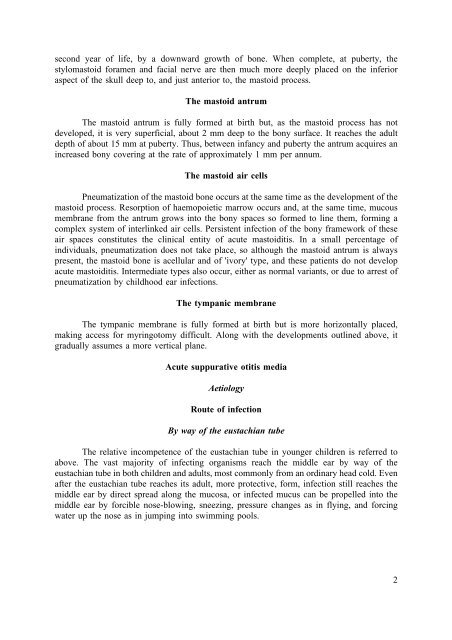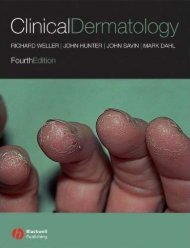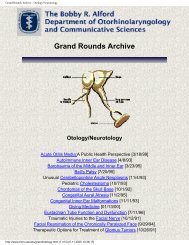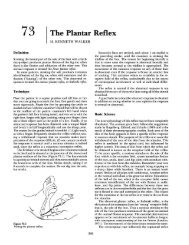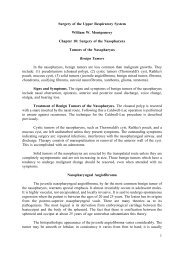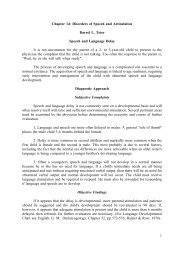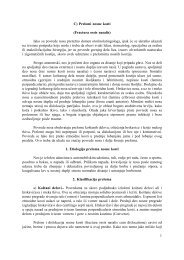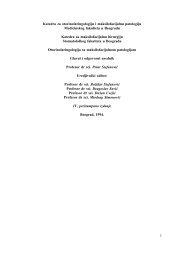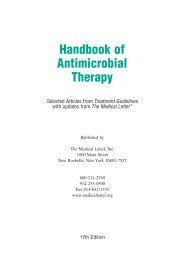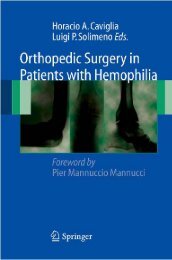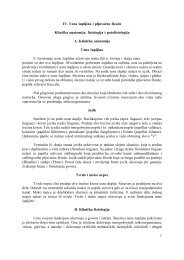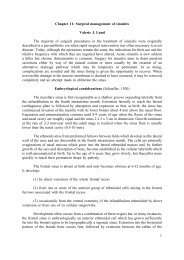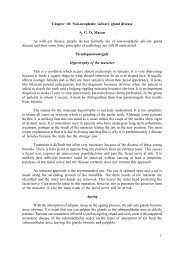1 Chapter 13: Acute suppurative otitis media and acute mastoiditis ...
1 Chapter 13: Acute suppurative otitis media and acute mastoiditis ...
1 Chapter 13: Acute suppurative otitis media and acute mastoiditis ...
Create successful ePaper yourself
Turn your PDF publications into a flip-book with our unique Google optimized e-Paper software.
second year of life, by a downward growth of bone. When complete, at puberty, the<br />
stylomastoid foramen <strong>and</strong> facial nerve are then much more deeply placed on the inferior<br />
aspect of the skull deep to, <strong>and</strong> just anterior to, the mastoid process.<br />
The mastoid antrum<br />
The mastoid antrum is fully formed at birth but, as the mastoid process has not<br />
developed, it is very superficial, about 2 mm deep to the bony surface. It reaches the adult<br />
depth of about 15 mm at puberty. Thus, between infancy <strong>and</strong> puberty the antrum acquires an<br />
increased bony covering at the rate of approximately 1 mm per annum.<br />
The mastoid air cells<br />
Pneumatization of the mastoid bone occurs at the same time as the development of the<br />
mastoid process. Resorption of haemopoietic marrow occurs <strong>and</strong>, at the same time, mucous<br />
membrane from the antrum grows into the bony spaces so formed to line them, forming a<br />
complex system of interlinked air cells. Persistent infection of the bony framework of these<br />
air spaces constitutes the clinical entity of <strong>acute</strong> <strong>mastoiditis</strong>. In a small percentage of<br />
individuals, pneumatization does not take place, so although the mastoid antrum is always<br />
present, the mastoid bone is acellular <strong>and</strong> of 'ivory' type, <strong>and</strong> these patients do not develop<br />
<strong>acute</strong> <strong>mastoiditis</strong>. Inter<strong>media</strong>te types also occur, either as normal variants, or due to arrest of<br />
pneumatization by childhood ear infections.<br />
The tympanic membrane<br />
The tympanic membrane is fully formed at birth but is more horizontally placed,<br />
making access for myringotomy difficult. Along with the developments outlined above, it<br />
gradually assumes a more vertical plane.<br />
<strong>Acute</strong> <strong>suppurative</strong> <strong>otitis</strong> <strong>media</strong><br />
Aetiology<br />
Route of infection<br />
By way of the eustachian tube<br />
The relative incompetence of the eustachian tube in younger children is referred to<br />
above. The vast majority of infecting organisms reach the middle ear by way of the<br />
eustachian tube in both children <strong>and</strong> adults, most commonly from an ordinary head cold. Even<br />
after the eustachian tube reaches its adult, more protective, form, infection still reaches the<br />
middle ear by direct spread along the mucosa, or infected mucus can be propelled into the<br />
middle ear by forcible nose-blowing, sneezing, pressure changes as in flying, <strong>and</strong> forcing<br />
water up the nose as in jumping into swimming pools.<br />
2


